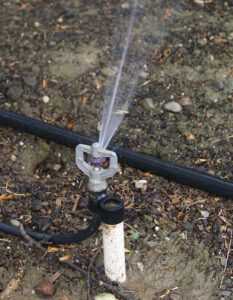
Intimidating language and paperwork along with requests for financial information can cause growers to shy away from applying for federal, state and local funding programs that offer financial incentives aimed at improving farming practices.
The application process doesn’t have to be intimidating, Michael Roots, Almond Board of California’s specialist for field outreach and education, said. With the proliferation of incentives and grants to persuade growers to adopt climate friendly and environmentally friendly practices, growers should take a closer look to see if they qualify, and what is required of them, Roots said. Growers may find stewardship practices already being done in their orchards may make them eligible for financial rewards.
That is not to say the process to find and apply for appropriate incentives is easy. Growers will have to put in the effort to prove their eligibility, Root said. One hurdle, he noted, is the cap on Adjusted Gross Income which is averaged over three years. He advises growers who have an interest in adopting conservation practices, investing in irrigation system improvements or equipment replacement first just go to their local Farm Service Agency office and talk.
“Tell them what you want to do,” Roots said. “They will look at your farm holistically, assess your farming operations and determine if you are eligible. Then you can develop a plan.”
Roots said the impetus to apply may be as simple as noting a neighbor acquiring a new tractor with financial assistance and going to the office to find out if you qualify. Larger projects may involve converting irrigation systems, adding monitoring equipment for scheduling and weather stations. Whole orchard recycling and compost applications and adoption of integrated pest management practices are all examples of common practices where incentives are offered.
Roots explained that the last Farm Bill contained more money to support a wide range of agriculture conservation projects. California also is supplying funding for water conservation, greenhouse gas reduction and healthy soils. In many cases, third parties, including resource conservation districts or industry groups, apply for the funding and administer the programs. For example, CDFA’s State Water Efficiency and Enhancement Program (SWEEP) provides financial assistance in the form of grants to implement irrigation systems that reduce greenhouse gases and save water on California agricultural operations. A CDFA Healthy Soils grant is being administered by American Pistachio Growers as well as several local resource conservation districts and other organizations supporting growers.
On the federal level, Farm Bill-funded programs include the Conservation Stewardship Program, which is designed to help growers maintain and improve existing conservation systems and adopt additional practices that address resource use. The Environmental Quality Incentives Program provides financial and technical assistance for projects that can improve water and air quality, conserve ground and surface water, increase soil health and reduce erosion and sedimentation.

Growers who are interested should:
1. Find Out What Is Available
Kelli Evans with Evans Agricultural Consulting in Live Oak said growers often do not realize the financial incentive programs that are offered.
“They tell me, ‘I wish I had known about this,’” she said. “They might be aware of the bigger programs, but with all the third parties administering the funding, there are a lot of opportunities out there. Finding one that will work for them is something they may not be used to doing.”
Growers who are interested in grant funding will have to look in multiple places for information, Evans said. Many grants are administered by third parties, including resource conservation districts that diligent searches are needed to find the right fit for each situation.
Almond Board, Roots said, is also helpful in connecting growers with appropriate programs.
2. Have a Plan
After finding the right program, Evans said growers should not expect immediate results. Any plan will have a long timeline. There is no guarantee that a particular incentive program will be offered in the next funding cycle.
Evans said it is important to know the window when applications will be accepted. The actual plan depends on the farm. Roots said an office visit at the nearest Natural Resources Conservation District office is the best place to start, particularly if you need help understanding the scope of the incentive program.
3. Determine Eligibility
For USDA grants, individual, entity or joint operations are eligible and must have a tax ID number. Those applying will need a farm and tract number, property deed or lease. Adjusted Gross Income requirement is less than $900,000 averaged over three years. The grower should also be up to date on Farm Service Agency records. The person submitting the application must also have an interest in the farming operation associated with the land being enrolled.
The land needs to be used in agriculture production, be privately owned and not receive other USDA program payments for the same conservation practice.
4. Make an Application
This is where a face-to-face meeting in the Natural Resources Conservation Service district office or local administering agency will be a good move. It is helpful to have the necessary paperwork listing land ownership or lease agreement, location and scope of project. Taking care of paperwork and verifications are important.
5. Wait
Depending on when you hit the cycle, Evans said, you should be prepared to wait after submitting an application.
Work on the project cannot begin before the agreement is signed and funding granted. Evans said she thinks of this stage as the “rebate stage.” After the plan is approved and contract is signed you can then begin the work, but you will have to pay all costs and wait for reimbursement after the work is completed and verified, Evans said.

Cecilia Parsons | Associate Editor
Cecilia Parsons has lived in the Central Valley community of Ducor since 1976, covering agriculture for numerous agricultural publications over the years. She has found and nurtured many wonderful and helpful contacts in the ag community, including the UCCE advisors, allowing for news coverage that focuses on the basics of food production.
She is always on the search for new ag topics that can help growers and processors in the San Joaquin Valley improve their bottom line.
In her free time, Cecilia rides her horse, Holly in ranch versatility shows and raises registered Shetland sheep which she exhibits at county and state fairs during the summer.















